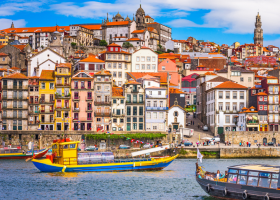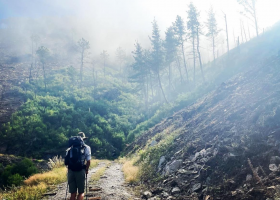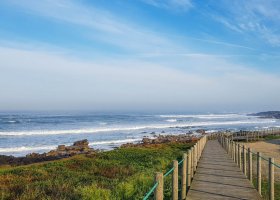
Create your own journey; Experience the best of Northern Spain at your own pace
This website uses its own and third-party cookies, for the proper functioning of the site and to generate usage statistics.
By continuing to browse we understand that you consent to our �ookie policy
The pilgrimage from León to Santiago de Compostela is a unique spiritual experience spanning approximately 300 kilometers, with a manageable difficulty level of 3 out of 5. Starting this journey in the historic city of León adds depth and authenticity to your Camino de Santiago trip. This route is ideal for those who want to meaningfully explore the Camino without covering excessively long distances.
The journey begins in the majestic city of León, renowned for its Gothic cathedral and rich medieval heritage. Throughout this journey, pilgrims immerse themselves in varied landscapes, from rolling hills to charming villages. The route is dotted with picturesque towns where walkers can rest and enjoy local hospitality. Discover historical monuments such as centuries-old Romanesque churches and medieval castles, which tell vivid stories of past eras.
The stretch from León is characterized by its scenic beauty and tranquil atmosphere. As you approach Santiago de Compostela, the excitement builds. The final city, with its cobblestone streets and ancient buildings, provides the perfect backdrop to conclude this transformative pilgrimage.Click Request quote [on the right-hand column] to get in touch with Spain is More for a personalized offer.
Our journey begins in León. The next day, you'll take a bus to Hospital de Órbigo. This decision was made for two reasons: 1) To keep the trip within two weeks, accommodating those who have limited time. 2) To bypass the less interesting exit out of León. If you wish to walk from León to Hospital de Órbigo, let us know, and we will include it in your offer. Remember, this will require adding an extra night to your trip.
✔ Daily departures throughout the year.
✔ Carefully selected hotels, always with a private bathroom.
✔ Personalized digital guide from Spain is More
✔ Stage customization: Yes, always.
✔ Excursion to Finisterre.
✔ Stay two nights in León to enjoy its gastronomy with tapas or explore its magnificent surroundings.
✔ Monastery of Samos.
✔ Roman Wall in Lugo. An extra night in Sarria will be needed.
✔ Spend a day in Ribera Sacra to see the vineyards and enjoy a beautiful cruise on the Sil River. An extra night in Sarria will be needed.
✔ The atmosphere in the city of Santiago.
![]()
Click here to explore the Camino Francés:
Find key insights on distances, terrain, climate, and vital tips.
León - Santiago
Camino De Santiago (French Way)

The old Roman regional capital is one of the main towns on the “French Way” – the original pilgrimage route. In the year 910, León became the capital of the kingdom we know today as Spain. Its medieval importance is reflected in monuments such as its breathtaking cathedral, where several ancient kings and queens are buried. In addition to its proud display of the San Marcos and San Isidro figures, León is also full of tapas bars and appealing plazas from which to observe travelers and their sore feet. In León you will encounter a genuine, authentic Spain, and yet there is much more to come on your journey.

The suburbs of León stand in complete contrast to its stunning city center. Instead of trekking through miles of industrial estates and flat plains, pilgrims are shuttled via a bus to Astorga. From here, the most pleasing part of the route begins. Another option is to stop at Hospital de Orbigo, 14 km (8 mi) from Astorga, where a gorgeous roman bridge creates a magnificent start to your pilgrimage. Astorga stands as an important town on the route and boasts interesting sites such as Gaudi’s Bishops Palace and a glorious cathedral.

A few kilometers after Astorga the landscape begins to change and becomes more mountainous. Before arriving to today´s destination you will pass through more beautiful, charming towns such as Castillo de los Polvazares that truly deserve a visit. Rabanal is a welcoming town with a great deal of pilgrim ambiance.
Distance: 20 Km

This stage through the mountains is unforgettable because you'll reach the famous Iron Cross (Cruz de Ferro) where pilgrims traditionally leave a stones representing a burden or desire and carried from their home towns at the base of the cross. Next, along the way to Molinaseca, the wondrous natural scenery is marked by a few villages. Molinaseca is crammed with charming restaurants frequented by pilgrims and locals alike, all enjoying the city’s picturesque streets and cozy cafés.
Distance: 25 Km

Today you pass through Ponferrada, the city with a famous 12th-century Templar castle, Castillo de los Templarios, at the town center. Ponferrada is a large mining city with a population of over 60.000 and an important stop on the Camino. As you leave, you´ll pass through Cacabelos, a small medieval stop for pilgrims, today home for a large number of wine-cellars (bodegas). Then, it’s on to Villafranca del Bierzo, often known as the “other” or “little” Santiago. Notice the 12th century Romanesque Church of Santiago and its north entrance, Door of Forgiveness. Villafranca del Bierzo is one of the most pleasant Camino towns found in the middle of Bierzo, which has established itself as one of Spain’s greatest wine regions.
Distance: 31 Km

Today, in the region bordering Galicia, you'll walk along ancient paths shaded by birches, oaks, chestnuts and poplars up to the emblematic mountaintop village of O’Cebreiro. There is a lovely 12th century Romanesque church with a fascinating legend, and curious old straw-roofed dwellings called Pallozas. This path offers some of the most panoramic views, but is also one of the toughest stages. Often shrouded in mist, the small stone village is extremely charming. If you arrive on a clear day, the views are dazzling!
Its possible to split this stage in two.
Distance: 28 Km

After a lot of uphill on one of the highest points of the trip, O Cebreiro, today will mostly be downhill. Once again, you´ll have many splendid views of the surrounding countryside. Today you'll also begin to notice stone granaries called "horreos". Also, the weather will change a bit, due to the winds and rain from the Atlantic Ocean. Although none of the castles still exist today, the name Triacastela, meaning "three castles," carries on. Limestone used to build the Cathedral de Santiago came from quarries near Triacastela.
Distance: 21 Km

The landscape begins to change as you begin the descent, perhaps a welcome relief after the last few days of hilly terrain. The route to Sarria give you the choice of two paths, one in a couple of hours allows a recommendable visit to the Benedictine Monastery of Samos, founded in the 6th century and one of the oldest in western Christendom. From here its a idyllic hike through the forrest to Sarria. The other route is a quicker way to reach the end.
Sarria itself is a town of about 13,000 residents and is the last place pilgrims with limited time can hike the minimum distance to the Cathedral de Santiago, 100 km, to receive their Certificate of Completion on the Camino. Because of this, Sarria is a major starting point for many pilgrims. You’ll notice an increased number of fellow pilgrims from here to Santiago.
Distance: 18 Km

Galicia is one of the most beautiful regions in Spain, both in nature and glorious tradition. Today’s walk is one of the most attractive stages of the entire Pilgrim’s Way; traveling through authentic rural Spain and its verdant forests, grassy meadows, fertile orchards and simple stone-built hamlets.
Distance: 23 Km

The terrain becomes flatter, though still hilly. Optimism takes over in this magnificent, lush area. By now your goal feels achievable. The journey continues along farm tracks and quiet country roads through the lush Galician countryside to Palas de Rei. Palas de Rei is a small village of around 2,000, with an illustrious past, although nothing remains today as a reminder since the historic city was engulfed in 1960 with the water from the dam and lake that were built.
NOTE: the two stages between Portomarin and Arzúa can be divided into three stages with the following km. distribution: 17, 16 and 20 km.
Distance: 25 Km

Today's views will seem somewhat familiar. A typical day on the Camino de Santiago, through rolling green landscapes, dotted with cows, stone walls and tiny Romanesque churches. Take time to talk and learn about myriad of legends and stories that this route offers. Today´s stage can also be divided into an extra night in Melide.
NOTE: the two stages between Portomarin and Arzúa can be divided into three stages with the following km. distribution: 17, 16 and 20 km. Or we can just divide the long stange between Palas de Rei and Arzua in two stages.
Distance: 28 Km

An exhilarating atmosphere unfolds as your journey's end draws closer. Pilgrims now feel the close joy of having reached their goal and they begin to revel in happiness and relief with the many companions they met along the way. Today’s walk is along natural pathways through tall groves of Eucalyptus that provide superb shade during your walk.
Distance: 20 Km

Congratulations, you achieved an admirable goal, so it's time for a number of traditional pilgrimage rituals. First, be sure to get proof of this feat: the last stamp in your pilgrim passport.
Along with the rituals, enjoy the End Station of the Pilgrim Route, Santiago de Compostela, which offers a veritable cornucopia of attractions and one of the world’s most important cultural centers. This university town exudes charm and has a myriad of cozy streets offering ample opportunity to sample the many local delicacies.
The Cathedral is surrounded by a historic center which is on UNESCO’s World Heritage Site list, and its old town is incomparable to any other. Its monuments stand as true works of art in different architectural styles.
Distance: 20 Km

True pilgrims continues further and finish their journeys in Finisterre. The tour goes by bus with an English-speaking guide from Santiago to Finisterre in the morning and returns to Santiago in the late afternoon. Just off the stunning, rugged coastline and the fabled “Costa de la Muerte” (Death Coast), a reef filled with shipwrecks and tales of legends captures a raw, natural beauty. On the coast’s westernmost point is Finisterre – meaning the world’s end. Romans named this coast because it was literally the end of the known world. For many pilgrims this is the symbolic endpoint of the pilgrimage.
The evening is spent in Santiago de Compostela.

Departure from Santiago.

Pilgrimage from Porto to Santiago via the original Portuguese route through Tui.
14 days / 13 nights
From 990 EUR/pers.

Iconic pilgrimage from León to Santiago. A real classic!
15 days / 14 nights
From 990 Euro/pers.

Pilgrimage from Oviedo to Santiago through breathtaking landscapes.
16 days / 15 nights
From 990 Euro/pers.

Pilgrimage along the St. James Way from Porto to Santiago along the coast.
16 days / 15 nights
From 1250 Euro/pers.

Results of research into the psychological benefits of a camino announced

njoy the Camino with the best planning